I have reprinted all my photos using the adopted lilac Hue style suggested by my Tutor as I like the result and further to his comments, I also re-took the photo of image 5 standing on the soap-box for a better composition and made some Photoshop improvements to some of the other images for example image 3 (please refer to my earlier blogs) . Included in the folder is my Tutor’s report, Shaun Mullins – 512659 – Photography 1 Context & Narrative – Assignment 3 (1) My 300 word introduction labeled 1 of 16 300-word-introduction The character descriptions from my friends and family and a printout of the associated anchoring text marked 6 of 16 a-self-portrait-as-regarded-by-others
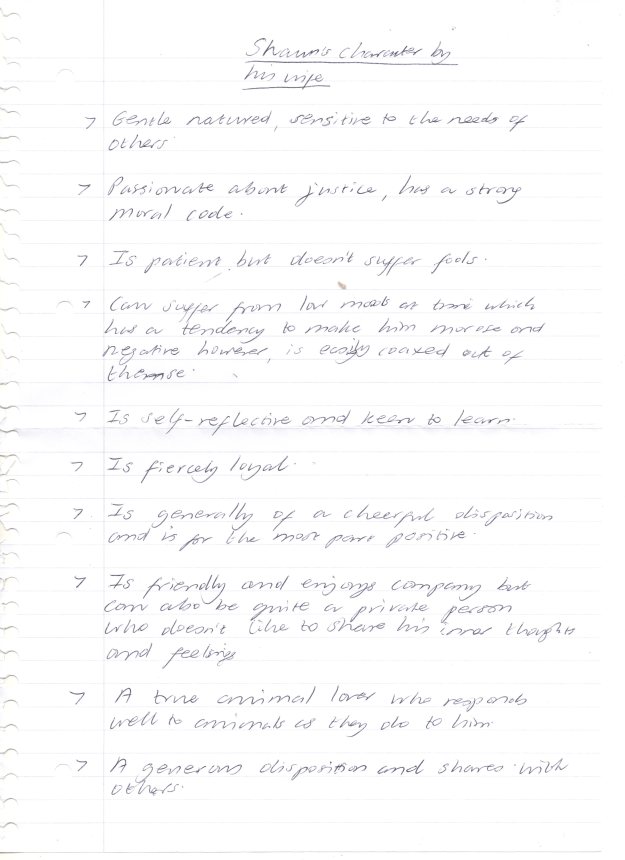
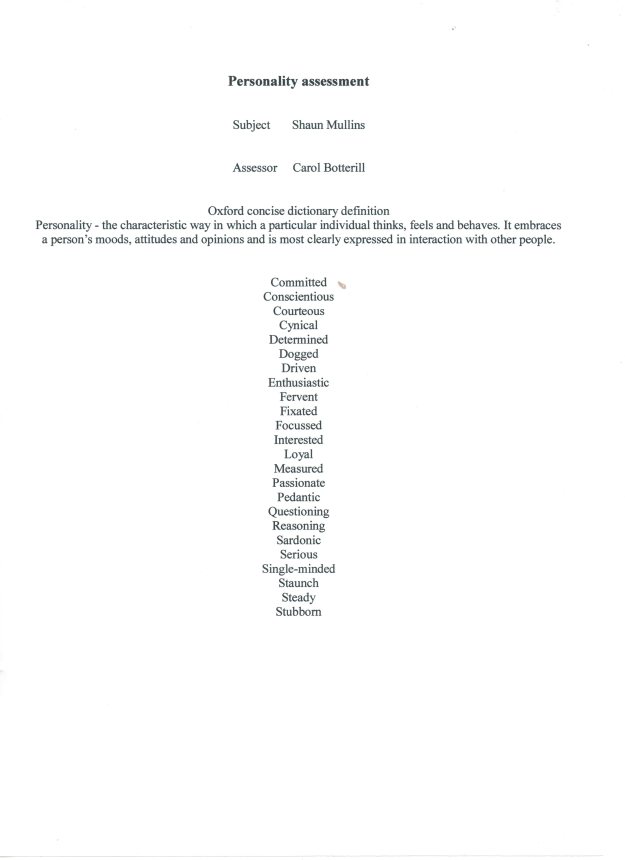

Tag Archives: character
Exercise – ‘Question for Sellers’ by Nicky Bird.
http://nickybird.com/projects/question-for-seller/
Nicky Bird purchased old unwanted photographs on Ebay, first waiting to see if anyone bid for them and if no-one did he purchased them himself and asked the seller, how they came to own the pictures and what they knew about them?
This is an interesting subject as I had never imagined that family photographs would ever become unwanted / redundant. Their meaning lost, their memories forgotten. That is until a recent event in my own life touched on this very subject. My wife’s Aunt died without issue in 2011, her husband had died the year before and she left her whole estate to her four nieces. When we were going through her things (which was a big task as she left a six bedroom house to be liquidated) I came across two old leather suitcases full of old family photos mainly of my wife’s Aunts family taken in the 30’s and 40’s. No one was interested as Sarah’s Uncle was the family link and if I hadn’t have taken these cases myself they would have been lost for ever. At the time I took them I had no thoughts of photography; but I felt a certain sense of responsibility that these lives should be remembered and these images should be kept. I can’t explain why, I just thought it was the right thing to do. Perhaps it is simply was that we all feel important and deep down wish to be remembered. Photography gives us this chance, even if the name and the memory is lost the image can still tell future generations that we existed, what we looked like, how we dressed, and how we posed, even what the world around us looked like. Photos are more important in this respect than say a painted portraits of a Victorian, for example. The photograph gives a better likeness, it captures the confidence or awkwardness of the subject; thus hinting at his or her character. The camera captures background that can tell a little about that moment in time and perhaps history that the artist may leave out or re-interpret. Sadly many family pictures will disappear over time and the surviving images will become more and more important. Imagine if photography had been around at the time of the first Roman Republic, even if only all that survived was a few family photos of only ordinary citizens our historians would have a field day!
In this exercise I am asked if Bird’s second-hand pictures displayed on a gallery wall elevate their status?
I guess the answer has to be yes, for now they are now the focus of attention and anyone or anything that becomes the focus of attention must by default become elevated in status.
Where does their meaning derive from?
Their meaning derives only from the context of their use if they have lost their original identity. An unwanted family photo of an unknown person, taken under unknown circumstances, perhaps even the location is unknown, then only the meaning that is attached to the picture from the exhibition exists.
When they are re-sold is their increased value because they are now art?
This is a commercial question and one that can not be simply answered with a yes or no. If the exhibition is successful, if the pictures can attract a contemporary historians eye, if the pictures can capture the imagination of art collectors, there is a lot of ifs, if the seller can market these images correctly / cleverly to the right market. Art is very subjective.
Exercise – Setting the scene
In this exercise I have been asked to watch a scene from the ‘Goodfeelas’ by Martin Scorsese. www.youtube.com/watch?v=OJEEVtqXdK8
What does this scene tell me about the main character?
He is confident, very self-assured, he has money, at least he likes to give the impression that he has and willing to throw it around. He wants to impress his girlfriend, he is a net-worker, he is a lair and probably a hood.
How does it do this? List the clues.
1, From the opening scene the main character gives his car keys with a Dollar bill to a doorman to park his car, he then proceeds to discreetly bribe his way to his table with Dollar bills that we later learn from his girlfriend to be $20 Dollar bills. As he enters the club from the tradesman’s entrance as he passes by key people he makes a point to greet them by name, some also with the bribe. He walks through the corridors, kitchens as if he owns them, as he enters the club the manager breaks off from talking to a customer to greet him and treating him as a VIP arrange for a table for him brushing off a complaint from a customer who had clearly been waiting for a table. The sound-track from 1960’s pop-band The Crystals, Then he kissed, me is played through out the scene to suggest romance. When his girl friend asks him what he does, he provides an un-plausible answer that he needed a second or so provide and he avoids eye-contact. He is given a bottle of wine from another table full of suited men implying that the main character is popular and important.
Working log-4 for Assignment three – Self-Portraiture
My last character assessment came from my friend Graham.



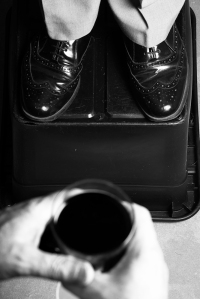
D800e, 24-120mm f/4 @112mm, 1/250, f/14, ISO-640. Flash


D800e, 24-120mm f/4 @78mm, 1/250, f/18, ISO-640. Flash.

D800e, 24-120mm f/4 @120mm, 1/250, f/9, ISO-125. Flash
My final presentation created from the text taken from all four statements to make the narrative for this project meant that I only needed two images from the three that I photographed.
Working log-2 for Assignment Three – Sarah’s Character Assessment
Planning for my next assessment was for my wife’s character assessment of me.

Taking extracts from her assessment I began to plan


Sketching ideas I then tried putting them in to practice with a camera. All but my last idea worked and talking it through with Sarah we came up with the idea of my hand locking a door to suggest the want for privacy. I thought that by adding Sarah’s hand on top suggests both privacy and intimacy as well as keeping a consistency to my images by including her in the shot.

D800e, 105mm f/2.8, 1/250, f/8, ISO-125, Tripod, Timer, WB-Auto, Remote flash, -3.0 EVA, 24mm zoom, I-TTL.
This next image was inspired by a lovely photo by Nan Goldin that she called ‘The Hug’, New York City 1980. I first saw this on the front cover of a book, Singular Images, Essays on Remarkable Photographs, edited by Sophie Howarth, that I recently purchased second hand. (This book is currently out of print.)


D800e, 24-120mm f/4, @86mm, 1/250, f/13, ISO-125, Tripod,Timer, WB-Auto, Remote flash, -3.0 EVA, 24mm zoom, I-TTL.
This last image is my hand wiping a tear from Sarah’s face.
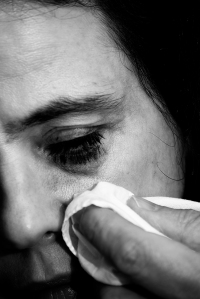
D800e, 55-300mm f/4.5-f/5.6 DX, @330mm (FX) 1/2o0, f/6.3, ISO-125, Tripod, Timer, WB-Auto, Remote flash -3.0 EVA, 24mm zoom, I-TTL.
I kept this image simple; so planning was not needed.

D800e, 24-120mm f/4 @52mm, 1/320, f/5.6, ISO-320.
I the final presentation I only used.
Working log-1 for Assignment Three – My father’s character assessment
For this assignment, I am tasked to create a photo or photos that are of a self-portraiture nature. The brief is fairly loose; but I have had an idea that I first checked with my Tutor to be sure that it would be acceptable.
My idea is to explore the question of my identity, how is my identity seen from other peoples perspective?
I have asked a couple of close friends and family to write a frank and honest assessment of my character and from these assessments I will extract ideas for creating images that represent Shaun Mullins as regarded by others.
My first assessment is from my father, Barrie Mullins.

Having been given my character assessment from my father, I started to jot down some thoughts and ideas. Having read it through several times I divided the text into subject matter to develop.

With these thoughts I narrowed it down to three subjects to use from my father’s assessment and began to think about what each can represent.

And looked again at the text and how my chosen subjects are used in context to my fathers narrative.
‘High ability’ (“when he wishes to exercise it.”)
‘He appears to denigrate any achievements’
‘A man that one would trust’
I now began to sketch and jot down ideas.
I made the decision to work in black-and-white for this assignment and as these are ‘self-portraits, I felt that it was more appropriate and perhaps stronger for the composition if the are all framed in a portrait format.
My first attempt was for ‘High ability’ with an idea that immediately came to me and I quickly made it without bothering to sketch it first.

However, I felt that it didn’t link to my father’s text, nor was it strong enough symbolically. I also decided that I want to make self-portrait styled pictures that only imply my presence with at most say only a hand, a shadow or just a part of my body, etc.

This was my next attempt; but I still felt that it didn’t convey the message of ‘High ability’. Moreover, perhaps even my father’s face was not necessary either. I moved on to another shot I had properly planned with a sketch.
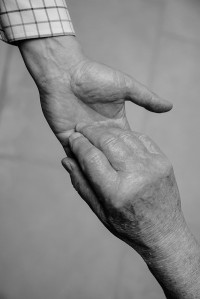
This shot is for the last image, ‘A man that one would trust’. My father is 87 and I thought about how this suggestion of trust could be manifested in an image linking my father and it occurred to me that giving my father a helping hand might work and this is the image I had in mind and I think it works.
My next image that I took was another attempt at ‘High ability’

However, I felt that this image still wasn’t strong enough and my wife didn’t like it either although she felt that the image of Sir Edmond Hillary conquering Everest was a strong symbol; so I had to organize a re-shoot with my father. Unfortunately, despite his keenness to help, his patience is very short and due to his age he tires very easily and quickly; so he was quit challenging to work with, particularly when some of the shots I needed were challenging to make particularly as I had restricted myself to a portrait format.

During this same shoot, I also attempted to get an image for ‘He appears to denigrate any achievements’. But again I felt that this just didn’t work.
On our next session together I had re-planned and the results for the two needed images I believe are now much stronger and meet the requirements that I was looking for.

This image is to represent ‘He appears to denigrate any achievements’ and I felt I needed to contrast praise with denial / refusal and I had the idea of simply my father clapping and with myself holding out my hands asking him to stop. I really only wanted the hands to symbolism the sentiment, this proved more tricky that first thought and when I tried to sketch my mental idea I struggled. I turned to my camera and fitting it to my tripod and tethering to a computer to see what the camera was seeing I tried different ways of composing the image. In the end I decided to lay the camera of the ground looking up whilst still tethered to my lap-top in order to see and compose and take the picture. With my father this still took over an hour to do and in the end I had to merge two photos together in Photoshop to get the desired combined poses in one image. My kitchen skylight worked to provide a nice blank background with a faint cross which is the frame of the pyramid skylight that also is a nice subtle addition to the image. Also, my fathers hands in the act of applauding with my own hands out stretched to ask him to stop appears to mimic the faint cross in the skylight.

By the time I had made some useful images for ‘He appears to denigrate any achievements’ my father was very tired; but my last image was fairly straightforward and easy to make as I could hold the camera in my hand and take the shot over my father’s shoulder for this image of my father holding a photo of Sir Edmond Hillary with my British and American Private Pilot’s Licences that he refers to in his assessment.
I now believe that I have three images that now work and link effectively to my fathers text creating a visual narrative. One or two of my images may be considered strong enough to stand alone; but they all clearly gain strength as a visual narrative when seen together and are linked to the text.
I have decided to only use the second and third images in my final presentation.
Project 2, Exercise – Metaphor – working log.
For this exercise I chose the poem ‘Not Waving But Drowning’ by Stevie Smith, 1902 – 1971.
I first read this poem over 20 years ago and re-discovered it when searching for a suitable poem for this exercise amongst the books on my book-shelves. This particular poem was published in, The New Oxford Book of English Verse, Chosen and edited by Helen Gardener, Oxford University Press.
Not Waving But Drowning, immediately resonated with me as my wife is going through a very difficult time with her family. However, I will not attempt to produce images that make reference to my personnel issues in this exercise; but I will explore other ideas to complement this poem.
I have discovered an interesting short recital by Stevie Smith of this poem on YouTube. https://www.youtube.com/watch?v=FKHWEWOrL9s
My idea is to take this poem and turn it in to a narrative of my own.
I began by writing down key words and phrases and then looking for ideas.
I also typed and printed the poem which I analysed and looked at each line and each paragraph

The first paragraph of this poem for my story is a man who is drowning but is not aware of his peril. Nobody heard him, because perhaps, he didn’t know how much danger he was in. However, his friends and family may have been able to see the danger; but dismissed it, thinking that he could cope.
For the second paragraph I interpret that our hero has now met his fate and his friends and family are making excuses for themselves.
In the final paragraph our hero has now drowned and is protesting against the excuses and as he now realizes – all too late, just how much danger he really had been in.
As I have thought this through, I was originally thinking of producing as many as 7 or 8 images. But then having discussed my ideas with my wife, she reminded me that I am searching for metaphors to convey my feelings. After a nights sleep I returned to my notes, re-read the exercises criteria and focussed on, “develop metaphorical and visceral interpretations rather than obvious and literal ones.” “Don’t attempt to describe the poem but instead give a sense of the feeling of the poem and the essence it exudes.” Re-reading these lines and referring back to my notes, I realized that I only needed three images in total – One for each paragraph: An image to represent his drowning in his own folly and an image to represent his friends discussing his fate; and a final image representing his loss.
I decided that before I could go any further with this exercise, I had to do some more reading to research ideas. I first turned to a book that I read when preparing for my last assignment with Art of Photography course, Illustration and Narrative, The Fundamentals of Creative Photography by David Prakel and published by AVA. I re-read the chapter on Communication which briefly covers semiotics. I then read Photography by Stephen Bull, published by Routledge. Chapters 3 and 4 helped me formulate my final ideas for this exercise. Chapter 3 provided me with a better insight in to the theory of semiotics; but it was chapter 4 on advertising that the proverbial penny dropped and I saw my solution in how to use semiotics for this exercise. The answer was the theory of relay and example mentioned in this book (page 68) a bank using images of conveying a feelings of joy with the caption, “This is what saving feels like.” This one passage provided me with the answer to my problem of finding the idea of simple images that can work in relay to my poem. The first two images will be relay and my last image will be both indexical and relay.
I then went back to my notes and the ideas began to form. The first image that began to materialise was the middle image and I thought of a wake. I wanted a fairly simple representation and all the wakes I have ever been to include a fair amount of booze; so I thought of just a picture of a mix of half filled glasses on a bar to represent the mourners.

I originally had an idea for my drowned victim having been overwhelmed by debt and thought an image representing brochures, catalogues, and unpaid bills pilled up high might make a good representation and so I sketched it as in idea; but on reflection I didn’t feel it was strong enough. Then I had the idea that drowning could be a metaphor for being overwhelmed by success or the pressure to succeed and drugs are becoming more and more common in the professional high flyer corporate world, with the use of cocaine becoming very common. I then sketched out some ideas and also looked on the web for images of drug use in order to provide a realistic looking image. My final image came to me when I was sketching the drug ideas, I thought of a body in a morgue and I found an image on line of naked feet with a label attached to one of the toes. This I could re-produce easily myself. Not my idea, but I doubt there is such a thing as an original idea anymore anyway.
I decided that with the resulting images, I would turn then from colour to black and white as I feel that black and white conveys more atmosphere / sense of feeling and emotion that colour does not and was best suited for this poem.

This is the first image I made. I used a silver and crystal cocktail tray, icing sugar, a razor blade, a rolled up old Turkish note and my mobile phone with a suitably chosen image downloaded from the internet. I first tried using strobe lighting but couldn’t get a good image due to the reflection; so I used natural light and two reflectors to direct the family-of-angels for the reflected light off the star etched in to the crystal tray. I used black felt material under the tray to get the jet black background. Camera was on a tripod, 105mm, f/2.8, prime-lens, 1sec, f/11, ISO-125, manual focus. Adjustments made in Lightroom and converted to grey-scale in Photoshop.

This is in fact a self-portrait, using a white mattress cover and sheet on my bed, I set my camera on a tripod, set to self-timer, 20 seconds, manual focused using edge of the bed as a focus point. Marked mattress cover with Cello-tape to indicate the boundaries for my feet. I used my Sekonic light-meter to get an incidence reading for a correct exposure, with my feet pointing towards the window; so using just natural light to keep it simple. 24-120mm f/4 zoom, @ 70mm, 1/125, f/4.5, ISO-320, manual focus. Adjustments made in Lightroom with grey-scale conversion made in Photoshop.

I had an arm-band from previous funerals that I draped over a picture, re-introduced the mobile-phone with the same image and added the drinks glasses and bottles to suggest the people chatting about the dead-man. Again I kept it simple by using only natural light. The camera was mounted on a tripod, 105mm f2.8 prime-lens, 1/5sec, f/5, ISO-320, manual focused. Adjustments made in Lightroom and converted to grey-scale using Photoshop.
My original idea was to start with the image of the drugs, then the image of the drinks and finally the image of the feet; but when I uploaded the images and reviewed it I felt that it worked better by starting from the point of view that he is already dead with the explanation of his death being the last picture.
Reflections for Assignment I


Shaun Mullins – 512659 – Photography 1 Context & Narrative – Assignment 1
I am pleased to blog that I received a good report for my first assignment for this course ‘Context and Narrative’.
This assignment was very similar to my last assignment for ‘The Art of Photography’ course which covered the subject illustration and narrative. For that assignment I had to find or invent a story / narrative that I could produce photos for both as a book / magazine cover and to illustrate the story itself. Having already researched a method of best practice to both prepare and carryout the work effectively, I put the same methods in to practice with this assignment – Namely, my brain-storming and storyboarding.
I took a risk when I decided to just used a mobile-phone as my only method of recording the images; but I felt I could create a better sense of authenticity for my particular story. I found Clive’s comment that I had created a character for myself very interesting. It hadn’t occurred to me. Nor had I ever considered creating a character for myself. Moreover, I would not have expected that by even having such an idea it would have made any positive contribute to the work. However, this is a new dynamic for me and something I will consider further.
Coursework

Clive’s comment on my coursework, is valid. The exercise for street-photography didn’t go too well for me as I feel very uncomfortable just taking pictures in public like that. Clive’s comment, “kaleidoscopic presentation of the street-photography and the dizzying angles.” is a fare comment as it was the result of my desperation to try and get some images of interest whilst working in an uncomfortable environment. Maybe, in a capital-city or historical-town full of tourists it is much easier to work with a DSLR; but in small provincial-towns and villages you get a lot of negative reaction from people that borders on aggression. To be honest this is not a field of photography that rocks my boat; but I will probably try again, I may book a street-photography course with Nikon and if working on my own I will prefer a more discreet camera such as that on a mobile-phone.
I am very grateful to Clive’s useful feedback and tips; I shall take them all on board.
Overall this assignment and this first section has been a very positive experience.






























